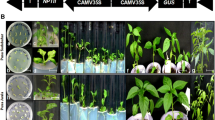Abstract
A system for genetic transformation of an elite prickly pear cactus (Opuntia ficus-indica L., cultivar Villa Nueva) by Agrobacterium tumefaciens was developed. Beginning with direct bacterial infection by using a hypodermic syringe to the meristematic tissue termed areoles, transgenic plants were obtained by selection with 100 mg l−1 kanamycin. Transient and stable GUS activities were monitored on kanamycin-resistant shoots and regenerated plants, respectively. Genetic transformation of regenerated plants growing under selection was demonstrated by PCR and Southern blot analysis; transgene copy number in the genome of transgenic plants ranged from two to six, while the transformation frequency obtained by the system reported here was of 3.2%. This method may be useful for routine transformation and introduction of several important genes in prickly pear cactus.
Similar content being viewed by others
References
Bravo H (1978) Las Cactáceas de México, 2nd edn. UNAM, México, p. 735
Cruz-Hernández A, Witjaksono, Litz RE, Gomez Lim M (1998) Agrobacterium tumefaciens-mediated transformation of embryogenic avocado cultures and regeneration of somatic embryos. Plant Cell Rep 17:497–503
Deblaere R, Bytebier B, de Greve H, Deboeck F, Schell J, Van Montagu M, Leemans J (1985) Efficient octopine Ti plasmid-derived vectors for Agrobacterium- mediated gene transfer to plants. Nucleic Acids Res 13:4777–4788
Droste A, Pasquali G, Bodanese-Zanettini ME (2000) Integrated bombardment and Agrobacterium transformation system: an alternative method for soybean transformation. Plant Mol Biol Rep 18:51–59
Escobar HA, Villalobos VM, Villegas A (1986) Opuntia propagation by axillary proliferation. Plant Cell Tissue Organ Cult 7:269–277
Finnegan J, McElroy D (1994) Transgene inactivation: plants fight back! Bio/Technol 12:883–888
Frame BR, Shou H, Chikwamba RK, Zhang Z, Xiang C, Fonger TM, Pegg SEK, Li B, Nettleton DS, Pei D, Wang K (2002) Agrobacterium tumefaciens-mediated transformation of maize embryos using a standard binary vector system. Plant Physiol 129:13–22
Galili G, Galili S, Lewinsoho E, Tamor Y (2002) Genetic, molecular and genomic approaches to improve the value of plant foods and feeds. Crit Rev Plant Sci 21:167–204
García-Saucedo PA, Valdez-Morales M, Valverde ME, Cruz-Hernández A, Paredes-López O (2005) Plant regeneration of three Opuntia genotypes used as human food. Plant Cell Tissue Organ Cult 80:215– 219
Guzmán-Maldonado SH, Paredes-López O (1999) Biotechnology for the improvement of nutritional quality of food crop plants. In Paredes-López O (ed) Molecular biotechnology for plant food production. CRC Press, Boca Raton, pp 553–620
Ishida Y, Saito H, Ohta S, Hiei Y, Komari T, Kumashiro T (1996) High efficiency transformation of maize (Zea mays L.) mediated by Agrobacterium tumefaciens. Nat Biotech 14:745–750
Jefferson RA (1987) Assaying chimeric genes in plants: the GUS gene fusion system. Plant Mol Biol Rep 5:387–405
Laimer M, Mendonça D, Maghuly F, Marzban G, Leopold S, Khan M, Balla I, Katinger H (2005) Biotechnology of temperate fruit trees and grapevines. Acta Biochem Pol 52(3):673–678
Llamoca-Zárate RM, Landsmann J, Campos FAP (1998) Establishment and transformation of callus and cell suspension cultures of the cactus-pear (Opuntia ficus-indica). J PACD 4:27–36
Llamoca-Zárate RM, Ponte IFA, Landsmann J, Campos FAP (1999) Biolistic-mediated transient gene expression in shoot apical meristems of the cactus-pear (Opuntia ficus-indica). Braz Arch Biol Tech 42(3):299–302
Machado MDF, Prioli AJ (1996) Micropropagation of Cereus Peruvianus Mill. (Cactaceae) by areole activation. In Vitro Cell Dev Biol 32:199–203
Mathews H, Litz RE, Wilde HD, Merkle SA, Wetzstein HY (1992) Stable integration and expression of glucuronidase and NPTII genes in mango somatic embryos. In Vitro Cell Dev Biol 28:172–178
McGranahan GH, Leslie CA, Uratsu SL y Dandekar AM (1990) Improved efficiency of the walnut somatic embryo gene transfer system. Plant Cell Rep 8:512–516
Miller M, Tagliani L, Wang N, Berka B, Bidney D (2002) High efficiency transgene segregation in co-transformed maize plants using an Agrobacterium tumefaciens 2 T-DNA binary system. Transgenic Res 11:381–396
Murashige T, Skoog F (1962) A revised medium for rapid growth and bioassays with tobacco tissue cultures. Plant Physiol 15:473–497
Polito VS, McGranahan G, Pinney K, Leslie C (1989) Origin of somatic embryos from repetitively embryogenic cultures of walnut (Juglans regia L.): implications for Agrobacterium-mediated transformation. Plant Cell Rep 8:219–221
Rascón-Cruz Q, Sinagawa-García SR, Osuna-Castro JA, Bohorova N, Paredes-López O (2004) Accumulation, assembly, and digestibility of amarantin expressed in transgenic tropical maize. Theor Appl Genet 108:335–342
Sambrook J, Fritsch EF, Maniatis T (1989) Molecular cloning: a laboratory manual, 2nd edn. Cold Spring Harbor Laboratory Press, Cold Spring Harbor NY. pp 1959
Santacruz-Ruvalcaba F, Gutierréz-Mora A, Rodríguez-Garay B (1998) Somatic embryogenesis in some cactus and agave species. J PACD 3:15–26
Silos-Espino H, Fabian L, Guevara-Lara F, Valverde-González ME, Osuna-Castro J, Paredes-López O (2003) Chemical and biochemical changes in prickly pears with different ripening behaviour. Narhung/Food 47:334–338
Taylor BH, Powell A (1983) Isolation of plant DNA and RNA. BRL Focus 4:4–6
Valdez-Ortiz A (2005) Incorporación del cDNA modificado de amarantina en semillas de tabaco, purificación y caracterización de esta proteína de reserva y posterior incorporación de este cDNA en maíz a través de Agrobacterium tumefaciens. PhD Thesis. Centro de Investigación y de Estudios Avanzados del IPN. 2005, Irapuato, Gto. México
Wenzler H, Mignery G, May G, Park W (1989) A rapid and efficient transformation method for the production of large numbers of transgenic potato plants. Plant Sci 63:79–85
Acknowledgements
We thank Dr. J.L Cabrera-Ponce from CINVESTAV-IPN for technical help, and CONCYTEG, OMNILIFE, CONACYT, COSNET and DGETA-SEP, Mexico for financial support.
Author information
Authors and Affiliations
Corresponding author
Rights and permissions
About this article
Cite this article
Silos-Espino, H., Valdez-Ortiz, A., Rascón-Cruz, Q. et al. Genetic transformation of prickly-pear cactus (Opuntia ficus-indica) by Agrobacterium tumefaciens . Plant Cell Tiss Organ Cult 86, 397–403 (2006). https://doi.org/10.1007/s11240-006-9123-1
Received:
Accepted:
Published:
Issue Date:
DOI: https://doi.org/10.1007/s11240-006-9123-1




